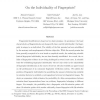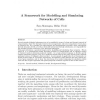36 search results - page 5 / 8 » Morphogenesis as an amorphous computation |
NCA
2010
IEEE
13 years 3 months ago
2010
IEEE
Programmability is an increasingly important barrier to the deployment of multi-robot systems, as no prior approach allows routine composition and reuse of general aggregate behavi...
PAMI
2002
13 years 8 months ago
2002
Fingerprint identification is based on two basic premises: (i) persistence: the basic characteristics of fingerprints do not change with time; and (ii) individuality: the fingerpr...
ENTCS
2010
13 years 6 months ago
2010
Several complex biological phenomena are to be modelled in terms of a large and dynamic network of compartments, where the interplay between inter-compartment and intra-compartmen...
SAC
2004
ACM
14 years 2 months ago
2004
ACM
Extracting object boundaries in thermal images is a challenging task because of the amorphous nature of the images and the lack of sharp boundaries. Classical edge-based segmentat...
DNA
2008
Springer
13 years 10 months ago
2008
Springer
Abstract. Nature is considered one promising area to search for inspiration in designing robotic systems. Some work in swarm robotics has tried to build systems that resemble distr...


